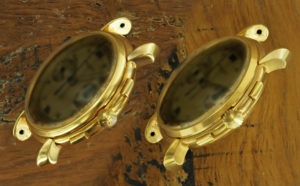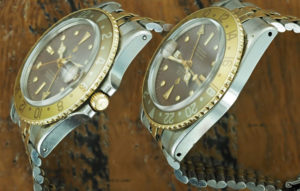The old fashioned way – almost abandoned, today – to rebuff scratched up cases or remove dents or nicks from beat up watches was an invasive procedure that could literally deform the original shape of a watch case, or at best remove forever that particular finish – whether sanded or lapped – that was unique to the factory’s specifications.

To a true lover of watch design like myself this practice was nothing short of sacrilegious and since the very early days of my career I started growing a particular passion for untouched – or barely touched – vintage watches. Only that condition would preserve the purity of the original design that determined the uniqueness of every model. Just like today, however, the buyer’s preference was determined by what the mass – driven by the market – privileged: back then it was the shiny, freshly re-polished watch. Trust me, refusing to re-polish an untouched watch – which I did several times – simply meant losing the sale and having to wait for another day and another buyer. And these clients were experienced, veteran collectors too! Only the least expert would let me decide for them, and accept to maintain their watch’s original condition even if that involved living with a scratch or a small dent on its case. I will keep blood chilling stories of beautiful, original dials refinished because of collectors’ intolerance to a small halo or patina for next time…
Some of my hometown’s biggest names in watchmaking would proudly include in the service a heavy re-polishing job that would often permanently remove all outer engravings, including case serial numbers and brand logos, like the Rolex coronet on snap on case backs. Sadly, even major manufacturers like Rolex and Patek Philippe would return watches with cases that were literally violated as part of the “official” service process, along with replacing original hands, dials and bezels with later replacement parts that would eventually devastate the integrity and value of the vintage piece. But all this for a reason: it was exactly what clients wanted. Slowly, however, things started to change in favor of preservation, and people – gradually absorbing the education offered from a handful of dealers – started appreciating the occasionally rough beauty of an unmolested watch over the glittering allure of the over-polished case. The request to service centers – factory authorized or not – to overhaul the movement without replacing any original visible part and leaving the case be started becoming so frequent, that they had to start considering to change their views on what was right or wrong regarding maintenance.

So we arrive to our days, when people on one hand ask: “has the case been polished?” – obviously unable to tell themselves, thus not having a real personal opinion or preference – and watch repairmen or service centers daring not touch a case any longer if they have the slightest hunch they’re looking at an untouched one. Unfortunately there are still a few out there that haven’t got it yet and never will, but they represent a truly sparse minority. In the meantime, however, re-polishing cases has not disappeared as a practice, but has evolved into a new concept that I like to think of as “sensitive” watch case restoration, something that a few extraordinary artisans have brought to a level of a real art. In fact, some incredibly talented hands today are capable of working on a previously devastated case and make it look like it was never touched in the first place. As a matter of fact, as far as I am concerned this is the only case in which this kind of intervention is justified. Different hands and different work styles offer different kinds of results, with a general tendency of the individual artisan to strive for a like-new effect as testimony of his/her professional virtues: I see it a little differently, but that’s something I like to share with my restoration clients only. In the meantime, new collectors keep on worrying about an issue that hardly exists anymore, just like traffic occasionally thickens for hours on a same spot, where there seems to be absolutely no cause for this to happen, other than for an accident happened hours earlier and yet not a single trace of it is still visible. Let me remark this: re-polishing the case of a vintage watch that has never been touched before is a very, very bad idea; likewise, leaving an already badly re-polished one…badly re-polished, is just as stupid, if you have a good opportunity to have it done right.
For Part III, click here.

I agree with your sentiments 100% on this matter. However, the problem arises with selling such watches : if only 99% of the people in this hobby were honorable and had integrity (as opposed to being a bunch of greedy cutthroats), and disclosed all of the facts of a particular watch fully (and the prices accordingly) when selling. The unpolished untouched specimen should command a premium over the restored one (which should in turn command a premium over the badly polished one), however greed prevails and most sellers/pseudo-dealers/dealers will not disclose a single thing, and rather try and sell as ‘untouched’ for maximum profit. So the problem still remains, and caveat emptor still applies.
Good point, Pierre:
However, as long as watch buyers will be motivated more by hoping to get a deal that will make them money rather than a good watch, their own greed will call for greed. If we as users discriminated on the sole basis of good looking and correct vs. no good at all, this phenomena would be very marginal; those who – for some reason – only collect the true untouched and immaculate will sure enough be willing to pay multiple times – not just a little more – than the market price of a great, albeit not necessarily like new, example. But in a market in which buyers are more and more motivated by buying something that is suspiciously new after half a century of use rather than a watch that is really worth buying for what it is, we’re being cornered in a place where a growing majority of collectors are either going to buy a lie or nothing at all. Which would be fair enough, if it wasn’t that more often than not they opt for the first choice of their own accord. As I like to warn my friends – too often uselessly – “if you keep asking for something impossible, sooner or later somebody’s going to find you just that”. So you’re right about everything, in a way: only, it doesn’t explain why dealers who choose to “disclose” or sell watches as they come need also to choose seeing potential buyers turn their offers down, to favor those of the other guys. In my view, you’re right about pointing your finger at the greed element, only you’re making the mistake of looking into one direction only; not too mention that extra greed added to the concoction by “consultants” who would never pull an inch of their own skin in the game, but sure enough don’t mind profiting on obvious advise that makes room for healthy business even tighter. Just a humble and personal point of view, obviously. Alex